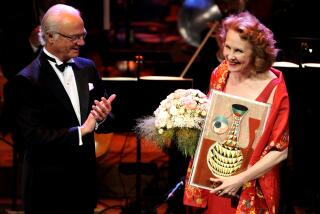His life simply ‘had to be music’
- Share via
When pianist Murray Perahia decided to study with Vladimir Horowitz in the 1980s, there was cause for worry. Horowitz famously ate other pianists alive. Few had questioned Perahia’s technique before he knocked on Horowitz’s door. He had already been hailed for his maturity, sensitivity and tonal beauty, especially in works by Mozart, Chopin, Schumann and Brahms.
So why did Liszt’s flam- boyant “Spanish Rhapsody” and Rachmaninoff’s knotty Etudes-tableaux suddenly show up on Perahia’s programs? “I wanted that,” Perahia said, speaking by phone from his home in London. “I wanted to go down that avenue for a while. And that is what we worked on -- Liszt, Rachmaninoff and the virtuoso Chopin.”
Perahia, now 62, survived his Horowitz experience and discovered another level of power in his playing. But there was only a temporary broadening of his repertoire: Of the three composers he worked on with Horowitz, only Chopin continues to appear in his recitals.
On Tuesday, he is scheduled to perform a number of Chopin pieces, including the demonically difficult Scherzo No. 4, at Walt Disney Concert Hall, a program that also includes Bach’s Partita No. 6, Beethoven’s Sonata No. 30 and Schumann’s “Kinderszenen.” The recital marks Perahia’s return to Disney Hall after appearing there as pianist and conductor with the Academy of St. Martin in the Fields in 2003, during the hall’s opening week.
David Dubal, a professor at the Juilliard School, recalls being concerned that working with Horowitz would adversely affect Perahia. But Perahia took what he needed and left the rest. “The musician in him is so great he ultimately extended his intellectual and muscular resources. He’s one of the few pianists over 50 whose technique has grown.”
As it happened, Perahia did hurt his hand in the early 1990s, but he traces the recurring injury not to playing octaves for Horowitz but to a cut on his right thumb that became infected. The injury was a major blow to someone who once said he doesn’t feel completely whole away from the piano. “All I thought about was that I just wanted to be in music whatever I do, even if I couldn’t play,” Perahia said. “It had to be music, because I had to understand deeper.”
Perahia, who grew up in the Bronx but has lived in London since the mid-1970s, said his hand injury allowed him time to slow down. He studied scores, listened to recordings (high on his list: Wanda Landowska’s “magisterial” Bach) and looked more deeply into composers such as Bach, Beethoven and Brahms. “It was a period of reflection -- of forced getting away. In the end, I saw it as a blessing.”
One of Perahia’s colleagues, Kenneth Sillito, artistic director of the Academy of St. Martin in the Fields, recalls that the pianist “was fairly despondent at that time.” So the academy asked Perahia if he’d like to conduct the chamber orchestra.
Perahia said he doesn’t see himself as a conductor, although as a teenager he studied conducting at the Mannes College of music in New York. “I’m a pianist,” he said. “I’m still involved with the mysteries of the piano and getting secrets out of it.”
Yet he once had another career goal in mind. “I wanted very much to be a composer but found myself drying up -- I couldn’t find the language,” he said. “So I stopped, although I’m writing a cadenza for a Mozart concerto I’m playing. I just wanted to be a complete musician. The piano allowed me to play many harmonies, and that’s why I gravitated to it.”
--
A will and a way
Perahia seems a slightly shy and unassuming man, but make no mistake: He owns an iron will. When he was young, his father’s business failed and Perahia was ready to form a jazz band (which he later did) to raise money for the family.
He grew up hearing important pianists such as Clifford Curzon insist that playing Bach on piano did the music an injustice. “I just felt this must be wrong,” Perahia said, adding that Bach’s music gains in color and dynamic nuance when played on a piano.
To ensure that his interpretations were nevertheless informed and supported by knowledge of 17th and 18th century conventions, Perahia studied the harpsichord before embarking in the late 1990s on his series of Bach recordings, including the six English Suites, Goldberg Variations, complete keyboard concertos and six Partitas.
The pianist was reluctant to talk about Glenn Gould’s acclaimed Bach, which was all about articulation, textural clarity and, above all, speed. “There was a time in the 1950s and 1960s when that kind of objective performance was liked,” Perahia said. “One can’t deny that Gould was a bit of a genius. But Bach’s music is full of feeling. The point is to be moved. So I never liked that style of playing.”
In recent years, Perahia has earned high praise, and won Grammys, for his Bach and Chopin records. According to Perahia, the two composers are not so unlike. “Chopin was very influenced by Bach,” he said. “The Mazurkas are very contrapuntal -- the harmonies come from the counterpoint.”
His latest recording, Bach’s Partitas (Nos. 2, 3 and 4), maintains the exalted elegance and purity of his earlier work. His carefully detailed pianism is natural-sounding, free of exaggeration and full of feeling.
“I think I was initially too Romantic,” Perahia said about his earlier approaches to Bach. “That’s who I am, basically.”
--
--
Murray Perahia
Where: Walt Disney Concert Hall, 111 S. Grand Ave., Los Angeles
When: 8 p.m. Tuesday
Price: $17 to $95
Contact: (323) 850-2000 or www.laphil.com
More to Read
The biggest entertainment stories
Get our big stories about Hollywood, film, television, music, arts, culture and more right in your inbox as soon as they publish.
You may occasionally receive promotional content from the Los Angeles Times.










